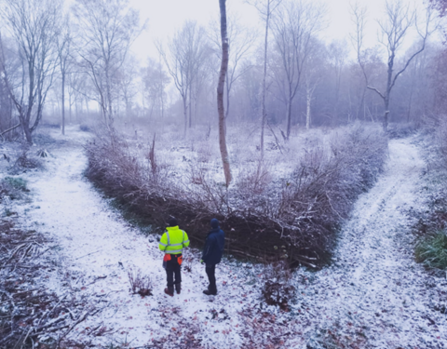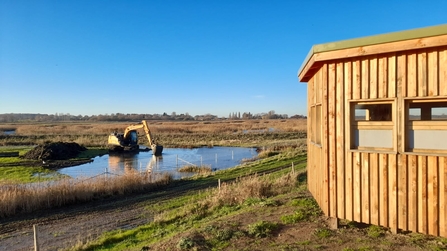Weekly wild news from our reserves - 16 December 2022
Frosty Carlton Marshes - Gavin Durrant
Although it looks fantastic, intense cold periods are treacherous for wetland wildlife, and many of our wetland birds will struggle to survive. Nearly all the open water has been frozen solid on Peto’s Marsh, which may cause problems for species such as bittern and bearded tits if it continues for a prolonged period.
Snipe on the Lackford Lakes visitor centre pond this morning – Hawk Honey

Last year's coppice coupe – Bradfield Woods – Anneke Emery
Wintery WeBS count
Wardens Frances, Andy and Gavin along with nine hardy volunteers set off in temperatures of minus 6 centigrade to do the monthly WeBS count at Carlton Marshes this week. They recorded over 250 snipe as well as 760 wigeon even though there was very little unfrozen water to be found.
The Wetland Bird Survey (WeBS) has been running since 1947 and monitors non-breeding wildfowl, waders and other waterbirds in the UK. 3000 WeBS counters make monthly counts at wetlands, continuing a tradition begun in 1947. WeBS surveys give an indication of population sizes, trends, distribution, and important sites for wildfowl and waders.
During the survey, the sun broke through the grey clouds and mist to reveal a stunning winter marsh landscape!
Frosty Carlton Marshes (https://www.youtube.com/watch?v=_WVRf7ha14A)
Frosty Carlton Marshes
Chilly cows
There has been some stunning scenery in the recent frosty weather at Church Farm. Our hardy British white cattle required more hay than usual to keep warm, and daily defrosting of their water trough - which was a very cold job for warden Jamie and his team!
Futureproofing for rising seas
It has been a busy month at Dingle Marshes where six new scrapes have been dug. These expanded on already existing wet features on the marshes. This work futureproofs some important habitats found at Dingle against the effects of coastal processes as the North Sea pushes the Dunwich shingle ridge inland. A concrete sluice has also been installed to improve the way we can move water around the reserve, connecting two water systems at Dingle.
The material dug out of the scrapes has been shaped into bunds and islands which will form places for birds to refuge or nest during inevitable future flooding events. The North East team have already recorded bittern and great white egret and many species of duck and geese using these pools.
Lightning strike
This oak tree at Bradfield Woods was split in two by a lightning strike in a recent storm - this highlights the importance of not being in the woods during thunderstorms or when there are high winds.
Balancing scrub
The North East reserves team tackled alder scrub alongside the ditches at Darsham Marshes this week. While scrub patches are important habitat for many species, scrub encroachment can lead to poor floristic diversity in the ditches through shading and leaf build up.
Habitat creation
Contractors have arrived on site at Carlton Marshes to begin a period of habitat creation and dyke work. The first project was the creation of a shallow pool in front of the 24hr mooring hide, which has already proved popular with kingfishers and otters. Hopefully, this work will allow more people to see these species and other wildlife from the comfort of the view point.

Habitat creation at Carlton Marshes – Gavin Durrant
Perching buzzard
This buzzard at Dingle Marshes used the fence post as a useful vantage point for hunting, resulting in a close-up on the trail camera. Buzzards eat small birds, mammals, and carrion, but will also eat large insects and earthworms when prey is in short supply. Listen out for their cat-like,'kee-yaaa' calls as they soar in high circles over grassland, farmland, and woodlands.
Perching buzzard at Dingle Marshes (https://www.youtube.com/watch?v=Q4AYVUI2PYU&feature=youtu.be)
Perching buzzard at Dingle Marshes
Fungi
Often brightly coloured, these life forms are neither plant nor animal, and come in a fantastic array of different shapes, with some very imaginative names! This week our teams spotted false turkey tail (also known as golden curtain crust) and a rather droopy jelly ear fungus.
Warden led walk
Waveney Valley Wildlife Group organised a guided tour of Carlton Marshes led by wardens Andy and Frances, where people had the chance to find out more about the wildlife, habitats and management of this fantastic reserve.
Red deer stag
This red deer stag with impressive antlers was caught on trail cam at Dingle Marshes recently. During the deer rutting season stags compete for hinds by locking antlers and establishing their dominance over one another. At the end of the season the stag will shed his antlers and take a well-earned break.
Eeery deer calls
The Chinese water deer rut has started at Carlton Marshes - *sound on*.
Frosty Carlton Marshes with Chinese water deer calling (https://www.youtube.com/watch?v=3cNxWro8Z2A)
Frosty Carlton Marshes with Chinese water deer calling
White deer
Warden Joe snapped this striking white fallow deer at Trimley Marshes this week. White deer are usually fallow, a species that is widely distributed across much of the UK and for which white is a recognised colour variety. White fallow deer are not as common as the other three main colour types of fallow (common, menil and black), but where they are present, they tend to stand out more obviously against other members of a herd or when in cover. The different colour varieties of fallow deer are thought to be a result of selective breeding from the times of medieval deer parks.

White deer at Trimley Marshes – Joe Underwood





































































